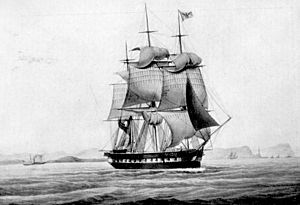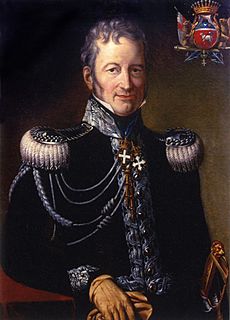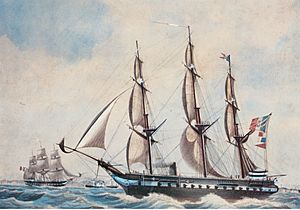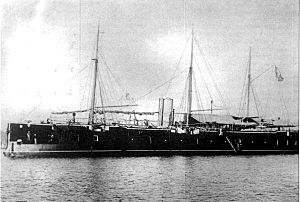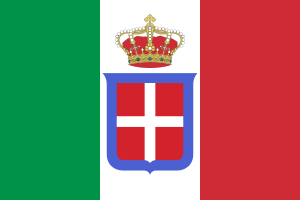Royal Sardinian Navy facts for kids
Quick facts for kids Royal Sardinian Navy |
|
|---|---|
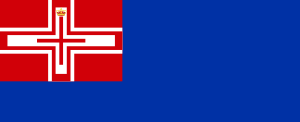
Ensign of the Royal Sardinian Navy from 1816 to 1848
|
|
| Founded | 1720 |
| Country | |
| Type | Navy |
| Role | Naval warfare |
| Engagements |
|
| Disbanded | 1861 |
The Royal Sardinian Navy was the navy of the Kingdom of Sardinia. This fleet was created in 1720. That's when the Duke of Savoy, Victor Amadeus II, became the King of Sardinia. He had already gathered some ships when he was the King of Sicily in 1713.
The Sardinian Navy took part in several important conflicts. These included the French Revolutionary Wars and the Napoleonic Wars from the 1790s to the 1810s. They also fought against pirates from the Barbary Coast, like in the Battle of Tripoli in 1825. A big step towards Italian unification was the Second Italian War of Independence in 1859. This war led to the creation of a united Italian state in 1861.
During the fighting in 1860, the navy of the Kingdom of the Two Sicilies joined or surrendered to the Sardinian Navy. This led to the creation of the Regia Marina (Royal Navy). This navy later became the Marina Militare, which is Italy's modern navy today, in 1946.
Contents
The Sardinian Navy began with Victor Amadeus II in the early 1700s. He became the King of Sardinia in 1720. Before 1713, Victor Amadeus didn't have his own navy. He used a few ships from a religious order and allowed private ships to attack enemies.
In 1703, Victor Amadeus was offered the Kingdom of Sardinia. He said no because he had no navy to protect the island. But in 1713, he got the Kingdom of Sicily. With it came a group of warships. He ordered that this group should have five large galleys and three other ships. He also created a special group of marines.
In 1718, Spain took over Sicily and captured Victor Amadeus's fleet. He had to rely on private ships again. But when he traded Sicily for Sardinia in 1720, he got his fleet back.
The Sardinian fleet was always small compared to the navies of bigger countries. Sardinia was a small country with limited money. It also had powerful neighbors like France and Austria. These countries made Sardinia spend more on its army than its navy.
During the 1700s, the fleet fought in wars against the Ottoman Empire, the Barbary Coast states, and Spain. In the 1790s, Sardinia joined others against France in the French Revolutionary Wars. After being defeated by Napoleon, King Charles Emmanuel IV gave up his throne. His brother, Victor Emmanuel I, went to the island of Sardinia. With little money and protected by the British Royal Navy, he let his navy shrink. By 1809, it had only a few small ships.
After the Napoleonic Wars ended in 1815, Sardinia got back its old lands. It also gained the city of Genoa, which had excellent shipbuilding places. By this time, the largest ship in the fleet had only 20 guns. Victor Emmanuel started a plan to build up the navy. Admiral Giorgio des Geneys led this effort, ordering new warships from Italian and British shipyards.
Victor Emmanuel did not stay king long enough to see his plan finished. A revolution in 1821 forced him to step down. His brother, Charles Felix, became king. The Sardinian fleet fought against the Barbary states twice in the 1820s. Geneys led an attack on Morocco in 1822, but it didn't achieve much.
In 1825, Geneys ordered the fleet to attack Tripoli, leading to the Battle of Tripoli. Sardinia won this battle. This success convinced Charles Felix to keep building new ships. He ordered several frigates, corvettes, and sloops in the late 1820s. These included large frigates like Carlo Felice and Regina. By 1829, the fleet had eight frigates in total. During this time, the fleet also protected Sardinian interests in the Middle East during the Greek War of Independence.
After Charles Felix died in 1831, spending on the navy dropped. His successor, Charles Albert, was not very interested in naval matters. In the 1830s, the fleet sent warships to places like South America. This was to protect Sardinia's trade in those areas.
In 1833, Sardinia made an alliance with the Neapolitans. That year, their combined ships attacked Tunis. They forced the city to pay for attacks on Italian merchant ships. Ship construction continued, and in 1834, the fleet got its first steam warship, the sloop Gulnara. In 1840, the paddle corvette Tripoli was launched. The next year, the powerful 64-gun frigate San Michele was launched. This ship carried the first shell-firing guns in the Sardinian fleet. By 1847, the fleet had five steamships.
Wars for Italian Unification
First Italian War of Independence
During the Revolutions of 1848, two groups of warships were sent to the Adriatic Sea. They went to support Venice's fight against the Austrian Empire. The Italian states hoped this revolution would lead to a united Italy. The small Austrian fleet was trapped by the Sardinian and Neapolitan ships.
However, the Italian fleet couldn't attack the Austrian ships directly. Trieste, where the Austrian fleet was, was part of the German Confederation. The German Parliament warned that an attack on Trieste would be seen as an attack on the Confederation.
The Neapolitan ships left after a revolt in their own government. This meant Sardinia had to send all its available ships to help. Even with more ships, the Italian fleet was weaker without the Neapolitans. More threats from Germany made Sardinia order its admiral, Giuseppe Albini, to stop the blockade.
Defeats on land, like the Battle of Custoza in July, led to an Austrian victory. Sardinia had to pull its fleet out. Albini took his ships to Corfu. Sardinia declared war again in March 1849. But the Sardinian army was defeated again at the Battle of Novara. This forced the country out of the war a second time. The Sardinian fleet had to leave the Adriatic Sea within fifteen days. During this war, the Sardinian ships had problems with sailors not following orders.
Crimean War and the Second Italian War of Independence
When Camillo Benso, Count of Cavour became the Sardinian naval minister in 1850, things changed. He improved discipline among the crews and made the fleet more modern. He ordered the steam frigate Carlo Alberto from Britain. It was the first ship in the Sardinian fleet to be powered by a screw propeller. Three more frigates followed in the 1850s.
In 1860, Cavour added two small ironclad warships. These were ships covered in iron for protection. These ships started a naval arms race with Austria. To make officers more disciplined and brave, Cavour worked to teach strong national pride at the naval academy in Genoa.
Cavour was also the Prime Minister of Sardinia. He led a more active foreign policy. Sardinia joined Britain and France in the Crimean War (1853–1855). Sardinia's main help was on land, but a small group of ships went to support the army. This war helped Sardinia build closer ties with France.
In 1859, Cavour planned the Second Italian War of Independence. This was a big step towards Italian unification. Sardinia secretly allied with France to defeat the larger Austrian Empire. During this war, the Sardinian fleet worked with the French Navy against Austrian ships in the Adriatic Sea. The powerful French ships made the Austrians retreat. The two navies planned to attack Austria from the sea. But victories on land ended the war before these attacks could happen.
The victory against Austria pushed the Italian states closer to unification. In late 1859 and early 1860, important events happened. Several central Italian regions voted to join Sardinia. In March 1860, Cavour returned to lead the navy and was also prime minister.
At the same time, Giuseppe Garibaldi led his "Expedition of the Thousand" to conquer the Kingdom of the Two Sicilies. Sardinia supported him. The commander of the Sardinian fleet was Vice Admiral Carlo Pellion di Persano. In April, the Tuscan fleet joined the Sardinian navy. In September, the Neapolitan fleet also joined Sardinia.
Persano used the fleet to block the port of Gaeta, a strong Neapolitan fortress. A French group of ships at first stopped Persano from attacking the fortress. But the French left in January 1861. This allowed a direct attack that forced the Neapolitans to surrender in February. The next month, the Kingdom of Italy was created under the Sardinian king, Victor Emmanuel II.
The Sardinian fleet became the main part of the new Regia Marina. This new navy was formed by combining the navies of Sardinia, Naples, Sicily, and Tuscany. The Regia Marina later became the Marina Militare, Italy's current navy, in 1946. This happened after Italy's defeat in World War II and the end of the monarchy.
In 1856, the Sardinian Navy had 2,860 men. The top officers included:
- 1 Admiral
- 1 Vice Admiral
- 3 Rear Admirals
- 7 Ship-of-the-line captains
- 6 Frigate captains
At that time, the fleet had these ships:
- 1 ship of the line (a very large warship)
- 1 sail frigate
- 3 steam frigates
- 2 corvettes (smaller warships)
- 4 brigs (two-masted sailing ships)
- 1 brigantine (a type of sailing ship)
- 1 gabarra (a flat-bottomed boat)
- 8 gunboats (small boats with guns)
- 8 steamships
See also
 In Spanish: Armada del Reino de Cerdeña para niños
In Spanish: Armada del Reino de Cerdeña para niños


